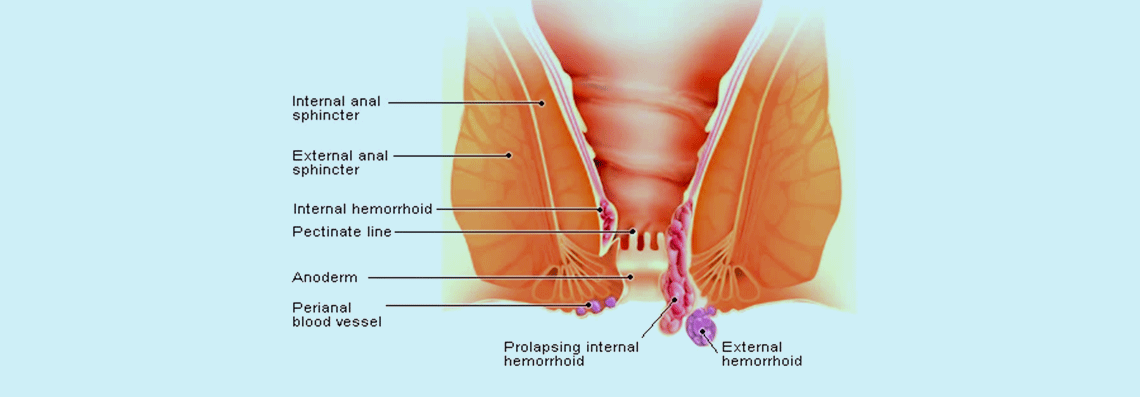Hemorrhoids (Piles) are swollen or enlarged blood vessels located in the smooth muscles of the walls of the rectum and anus. They are cushioned by smooth muscles and connective tissue and are classified by where they are located in relation to the pectinate line, the dividing point between the upper 2/3 and lower 1/3 of the anus. This is an important anatomic distinction because of the type of cells that line the hemorrhoid, and the nerves that provide sensation.

Symptoms
Enlarged hemorrhoids are associated with symptoms such as itching, mucus discharge, burning at the anus, severe pain, a sensation that the bowel is not really empty, and bleeding without pain. Hemorrhoids are classified into following general categories:
- internal, originating in the rectum, and external, originating in the anus.
- Bleeding or Non-Bleeding Piles depending on condition of bleed
- three vascular cushions in the anus, positioned at the 3-, 7- and 11- o'clock positions.
Hemorrhoids (Piles) is classified into four grades:
- Grade I: There are small inflammations, usually inside the lining of the anus. They are not visible.
- Grade II: Grade II piles are larger than grade I piles, but also remain inside the anus. They may get pushed out during the passing of stool, but they will return unaided.
- Grade III: These are also known as prolapsed hemorrhoids, and appear outside the anus. The individual may feel them hanging from the rectum, but they can be easily re-inserted.
- Grade IV: These cannot be pushed back in and need treatment. They are large and remain outside of the anus.
Causes
Hemorrhoids (Piles) are caused by increased pressure in the lower rectum.
The blood vessels around the anus and in the rectum will stretch under pressure and may swell or bulge, forming piles. This may be due to:
- chronic constipation
- chronic diarrhoea
- lifting heavy weights
- standing or sitting for long periods,
- eating a low-fiber diet,
- pregnancy
- straining when passing a stool or the tendency to develop pile may also be inherited and increases with age.
Diagnosis
A doctor can usually diagnose hemorrhoids (Piles) after carrying out a physical examination. They will examine the anus of the person with suspected piles and may ask the questions like whether any close relatives have piles, has there been any blood or mucus in the stools, has there been any recent weight loss, have bowel movements changed recently or what color are the stools?
For internal piles, the doctor may perform a digital rectal examination (DRE) or use a proctoscope. A proctoscope is a hollow tube fitted with a light. It allows the doctor to see the anal canal up close. They can take a small tissue sample from inside the rectum. This can then be sent to the lab for analysis.
The physician may recommend a colonoscopy if the person with piles presents signs and symptoms that suggest another digestive system disease, or they are demonstrating any risk factors for colorectal cancer.
Treatments
In some cases, piles resolve on their own without the need for any treatment when causative factors are prevented or removed. However, some health tips or herbal remedy can help significantly reduce the discomfort and itching that many people experience with piles.
Diet: Diet is believed to have a big impact in causing—and preventing—hemorrhoids. People who consistently eat a high-fiber diet are less likely to get hemorrhoids, while those people who prefer a diet high in processed foods face a higher hemorrhoid risk.
- Rich Fiber Diet: There are two types of fibres – Soluble & Insoluble. The soluble kind forms a gel in digestive tract and can be digested by friendly bacteria, while insoluble fiber helps bulk up stool. To promote a healthy gut, you need both.
- Legumes including beans, lentils, peas, soybeans, peanuts, and chickpeas, are the edible seeds of plants in the Fabaceae family. They’re loaded with both kinds of fiber but especially rich in the soluble type. Most adults should get 21–38 grams per day. Lentils and other legumes can bulk up stool, making it less likely that they have to strain when passing the stools. This can help prevent hemorrhoids or ease symptoms.
- Whole Grains: These are nutritional powerhouses, because they retain their germ, bran, and endosperm, which are loaded with beneficial components like fiber. Whole grains are especially rich in insoluble fiber. This helps move your digestion along, which can help reduce pain and discomfort associated with piles.
- Cruciferous vegetables include broccoli, cauliflower, Brussels sprouts, arugula, bok choy, kale, radishes, turnips, and cabbage and they’re predominantly known for their anticancer properties, they also deliver an impressive amount of insoluble fiber. Diversity of gut bacteria is linked to a more resilient gastrointestinal system, as well as improved immunity. Both this properties, insoluble fiber content & improved immunity, make cruciferous vegetables a great choice for preventing piles.
- Root Vegetables: Root vegetables like sweet potatoes, turnips, beets, rutabagas, carrots, and potatoes are filling, rich in gut-healthy fiber and packed with nutrition. As they reduce constipation, it may ease piles symptoms.
- Bell peppers & Celery delivers a lot of water, as well as fiber. This softens the stools and diminishes the need to strain.
- Apple & Peers, be sure to eat these fruit with the peel on, as that’s where a lot of the piles-defying fiber can be found. Pears & apples boast an impressive amount of fiber. Similarly, bananas & berries are considered fibrous, raspberries stand out as a fiber-packing powerhouse.
- Hydration: Keeping one hydrated with sufficient fluids will help make stools softer and easier to pass.
What should be avoided:
- Spicy foods. While not necessarily low in fiber, spicy food may increase pain and discomfort associated with hemorrhoids.
- Caffeinated beverages. These beverages, especially coffee, may harden your stools and make it more painful to use the restroom.
- Alcohol. Like caffeinated beverages, alcoholic drinks can dry up your stools and exacerbate the discomfort of piles.
- Low-fiber foods including Dairy products, White flour, Red meat, Fried foods, Processed meats, Salty foods and Caffeine containing drinks.
Lifestyle changes
A doctor will initially recommend some lifestyle changes to manage piles like
- Losing body weight may help reduce the incidence and severity of piles.
- Exercising like yoga, jogging and running for better metabolism and avoiding straining to pass stools and Heavy weight lifting.
- Regular cleansing of the rectum & anus regions.
- A normal and healthy sex life should be followed.
- Use of Sitz Bath: A sitz bath is a warm, shallow bath that cleanses the perineum, which is the space between the rectum and the vulva or scrotum.
- Avoiding sitting or standing for long periods.
The Ayurveda way of healing
Ayurveda is the most sought treatment in the management of haemorrhoids owing to the miraculous effect of herbs mentioned in Ayurvedic texts. Herbs used for ayurvedic treatment of piles include Psyllium Husk, Haritaki, Jimikand, Amla, Papaya, Ginger, Jambul, Guggulu, Neem, Daruharidra, Nagkesar, Chitrak, Raal and Radish which are very effective in systemic & local management of piles. These herbs comprehensively act on the aetiological sites for piles by majorly toning GIT (Gastrointestinal Tract) motility & secretions and help prevent chronic constipation. Besides, these herbs offer synergistic benefits by providing instant symptomatic relief via significant anti-inflammatory, haemostatic, anti-microbial, wound healing, Liver protective, metabolic corrective actions, toning functions of Gastro–Intestinal Tract as whole. These herbs also exerts haemostatic action by toning the blood micro-capillaries, thereby checks bleeding per rectum significantly and exerts anti-inflammatory action by inhibiting inflammatory mediators like leukotriene, thereby controls pain & itching in rectum region. Here, neem specifically acts as anti-microbial agent against a wide spectrum of bacteria, fungi & protozoa, inhibiting their growth without disturbing intestinal microflora, thereby checks any kind of secondary infection near the rectum.
All these herbs have been incorporated in a product named Amroid which is available as oral tablets for systemic action and ointment for local application. Amroid dual therapy offers a comprehensive management in hemorrhoids and is a good candidate for inclusion in any regimen of piles management.


